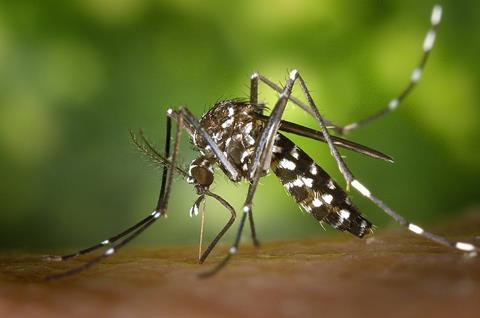As Europe grapples with the growing threat of tropical diseases brought by the Asian tiger mosquito, a research breakthrough led by the UK Centre for Ecology & Hydrology (UKCEH) is enabling scientists to accurately predict towns across the continent where there is a high risk of dengue fever.

Global movement of people, trade and climate change, are now putting half the world’s population are at risk of contracting dengue fever. Commonly referred to as the ‘bone breaker’, the disease may cause severe muscle and joint pain, and in some cases can result in internal bleeding and death.
READ MORE: First locally transmitted dengue cases reported in Iran
READ MORE: Indian Ocean surface temperature could help anticipate dengue outbreaks
The spread of the Asian tiger mosquito (Aedes albopictus) has caused local outbreaks of dengue in France including Paris, as well as Italy and Spain, contracting the virus by biting returning travellers who were infected while abroad and then transmitting it to other people in the area.
Scientists expect this invasive mosquito species to eventually gain a foothold in the UK.
Improving disease prediction
Previous disease risk predictions indicated large regions, such as the whole of southern Europe, had a similar risk of local dengue cases over long timeframes, leaving local authorities uncertain whether their area was likely to be affected and action to prevent outbreaks was necessary.
But the UKCEH-led advanced high-resolution modelling divides Europe as well as eastern Asia and North America into 10km squares, providing daily risk assessments for each area.
The new research involves a more detailed study of the entire life cycle of a mosquito, examining the impact of local climate and competition for food on species traits such as how long it lives and the number of eggs it lays. This provides more accurate assessments of where, when and for how long there are likely to be local dengue cases.
Correct forecast
The new modelling has already correctly predicted the locations of several towns that have gone on to have their first dengue outbreaks this year including La Colle-sur-Loup, Baho and Montpellier-Pérols in southern France, and Vila-seca, north-east Spain.
Dr Dominic Brass, an epidemiological modeller at UKCEH, who led the study, published in Nature Communications, says: “We predict that the parts of Europe most affected by dengue fever will continue to be southern France and northern Italy, due to a favourable climate, a stable mosquito population and the high number of travellers returning from tropical countries where the disease is prevalent.
“However, areas of risk are expanding northwards. Our ongoing research is modelling of the likely extent of future outbreaks in Europe under future climate change.”
Guiding action
The study team, from UKCEH, University of Glasgow, University of Reading, and Biomathematics and Statistics Scotland, hopes its more accurate predictions will guide preventative measures in areas that are at risk of dengue outbreaks. Possible action includes checking areas where mosquitoes typically lay their eggs such as standing water, as happened at the Paris Olympics, as well as advising the public to protect themselves against bites.**
Study senior author Dr Steven White of UKCEH says: “Our novel modelling technique shows remarkable accuracy for identifying the seasonal patterns and mechanisms of the risk of dengue fever outbreaks, providing a valuable tool for authorities drawing up action plans to prevent and control the spread of the disease.”
Rapid spread
In regions where Asian tiger mosquitoes are already established – including 13 countries in Europe – it is invaluable to know the times of year when there is greatest risk of a dengue fever outbreak, and how severe the risk is.
For other areas, it is useful to know what the disease risk would be if the species did arrive. This change can happen fairly quickly; Paris, for example, went from the first detection of the tiger mosquito in 2015 to having a dengue outbreak last year.
So far, the French capital is the most northerly place in Europe where there has been a local outbreak of dengue fever, and it also had a locally acquired (autochthonous) case of chikungunya disease in July after someone was bitten by an infected Asian tiger mosquito.
The UKCEH researchers say the modelling principles used in the dengue fever study can also be applied to other diseases transmitted by the tiger mosquito, such as chikungunya or Zika. They are currently drawing up risk maps for these diseases.
Asian tiger mosquito eggs have been found in south-east England, but the species has not yet become established in the UK. However, the research team warns this is likely to change in the future as the UK feels the effects of climate change.







No comments yet